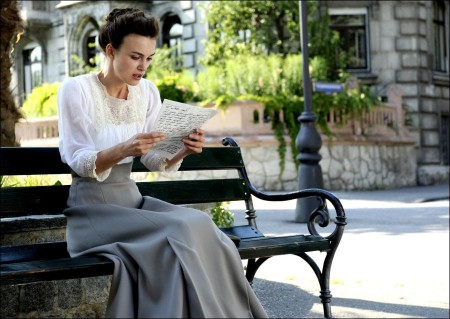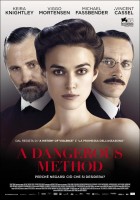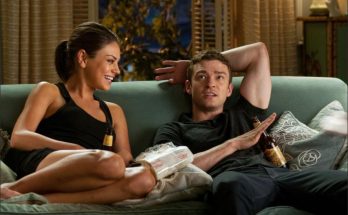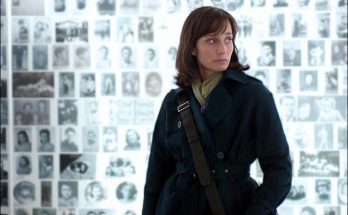Zurich, 1904. 29-year-old psychiatrist Carl Jung (Michael Fassbender) is at the beginning of his career, and lives with his pregnant wife Emma (Sarah Gadon) at Burgholzli hospital. Inspired by Sigmund Freud’s (Viggo Mortensen) work, Jung tries Freud’s experimental treatment known as psychoanalysis, or the talking cure, on 18-year-old Sabina Spielrein (Keira Knightley).
Sabina is a well-educated Russian who speaks fluent German, has been diagnosed with hysteria, and is known to be disruptive and violent. In talks with Jung, she reveals a childhood marred by humiliation and beatings from her authoritarian father. The psychoanalysis uncovers a disturbing sexual element to her dysfunction, which upholds Freud’s theories connecting sexuality and emotional disorders.
Through his correspondence on Sabina’s case, Jung forges a friendship with Freud, and their first meeting is a marathon affair. Relationships deepen between Jung and Freud, who sees Jung as his intellectual heir, and between Jung and Sabina, who is brilliant despite her ailment. Her treatment is successful, and Sabina pursues a career as a psychiatrist with Jung’s encouragement.
From Stage to Screen
A Dangerous Method began life as a screenplay in the mid-1990’s. Academy Award® winning screenwriter Christopher Hampton had a keen interest in psychoanalysis, and spent a great deal of time researching the relationships between Jung, Freud and Sabina, visiting the Burghölzli hospital in Zurich where he read her case history. These intelligent figures greatly appealed to Hampton, as he explains, “These people were pioneers and psychoanalysis was a revolutionary idea. It opened many closets and revealed many taboos. At the end of the nineteenth century, great currents of new ideas were brought into being which opened up a whole new way of thinking about society.”
Hampton went on to develop the material into a stage play called The Talking Cure, which had a successful run at the National Theatre in London with Ralph Fiennes starring as Jung. A few years later, acclaimed auteur David Cronenberg asked Hampton to adapt the play into a new screenplay for him to direct. As Cronenberg elaborates, “In Christopher Hampton’s original play I knew I had found a rich vein to mine for the screen. This tale of emotional variance, overshadowed by the portents of WWI, promised an insight into two intense and inextricably interwoven relationships. The fact that the characters were gifted true-life figures, and that the triangle of Jung, Freud and Sabina resulted in the birth of modern psychoanalysis, made it all the more tantalizing to me.”
Hampton began to develop his play, weaving historical events and quotes from the real-life personalities into a dramatic story of a debate of ideas. Cronenberg took the project to his good friend Jeremy Thomas (the Academy Award® winning independent producer), who has a reputation for working with highly individual filmmakers and had previously teamed with Cronenberg to make the critically acclaimed and award-winning films Crash and Naked Lunch. For Thomas, the appeal was immediate. As he explains, “The exciting pairing of director David Cronenberg with the great playwright and screenwriter Christopher Hampton would be too rare an event for me to miss. The opportunity to work with David again on a project of such note seemed a natural fit with this very interesting clash of ideas on screen. There is an enormous amount of dueling in the dialogue which I thought could be very attractive to watch when played by very good actors, and have an impact on an audience when directed by a wonderful director with a magnificent score.”
For Hampton, the opportunity to work with Cronenberg, a filmmaker he admired, was one he approached with relish: “I think David has a unique combination of extremely cool objectivity, and pretty violent engagement. A really original combination which fits this story very well, because it’s a story about people who are attempting to operate the rules of civilization and steer their patients towards ‘the norm’, whilst becoming increasingly aware that there is no norm and that they themselves, like all of us in certain respects, live right out on the wild fringes and have to cope with these contradictions as best we can. David is a wonderful director to encompass these contradictions and make sense of them.”
For his part, Cronenberg was captivated by the idea of directing a film about three charismatic figures from history, including Sabina; a relatively unknown figure who greatly influenced both men professionally. As he says, “Sabina was someone who contributed hugely to the theories of both men, something that no one knew until a cache of letters was discovered, her letters to and from Freud and Jung, and their letters to her. Their passion came through their articulation, their theories and their abstract thoughts. They were really quite fascinating people and it’s a fantastic story.”
For Thomas, a producer widely recognized for his distinctive films, this little-known story was one he knew he had to bring to the screen, “I have always been drawn to make unusual stories that often involve extreme behavior. At the heart of A Dangerous Method is a fascinating story that highlights how even those who understand humanity best can fall prey to mankind’s most basic emotions. Love, sexual passion, ambition, deceit, emotional breakdowns, explosive disagreements and apocalyptic dreams set the foundation for the pivotal moment when Jung, Freud and Sabina came together and then split, forever changing the face of modern thought. These intimate dynamics twinned with the broader span of history is what makes this film irresistible for me.”
Jung, Freud and Sabina On-Screen
When it came to choosing actors to portray these historical figures, all of whom were at key stages of their lives when the story took place, specific casting was crucial. As Thomas says, “This is an exploration of the human mind through characters that are young. Jung is thirty, Freud is fifty, Sabina is in her early twenties and Gross in his early thirties. Michael Fassbender, Viggo Mortensen, Keira Knightley and Vincent Cassel were all actors that were desired by David for these roles, and I thought they were magnificent choices.”
Sabina Spielrein was one of the first female psychoanalysts, a pioneer in her specialist field of child psychology. Yet, she is barely mentioned in the history of psychoanalysis, despite the fact that in 1912 she presented to the Psychoanalytical Society her conception of the sexual drive as containing both an instinct of destruction and an instinct of transformation. In this presentation there is strong evidence that Sabina influenced the work of both Jung and Freud; from Jung’s ideas of archetypes of the feminine in men and the masculine in women (transformation), through to Freud’s theory of the sex instinct and the death instinct. Freud later acknowledged in one of his books that Sabina led him to this path of thought, whereas possibly due to the nature of their relationship Jung never publicly acknowledged that her ideas had influenced his thinking.
It was only with the discovery of Sabina’s hospital records, her personal journals and correspondence with Jung and Freud, which has now been published, that it became apparent she inspired both men’s ideas.
Cronenberg explains what compelled him to bring these complex true-life figures to the screen: “With A Dangerous Method, I sought to make an elegant film that trades on emotional horror, but loses none of its power to seduce. I was stimulated by offbeat and intimate details that illuminate the three leads themselves, and that give a sense of what it must have been like to be at once trapped and liberated by their cerebral and physical bonds. It was a strange ménage à trois, not that Sabina had any sexual relations with Freud, but still there was love in each part of the triangle, including between Jung and Freud; there was an incredible affection and friendship between them.”
Michael Fassbender – Carl Jung
Michael Fassbender, the versatile and much in demand young actor, was chosen to play Carl Jung, a character he was thrilled to take on as he was intrigued by this relatively unknown episode in Jung and Freud’s lives. As he explains, his feeling is that Sabina did indeed influence both these men in their work, “According to the information Christopher Hampton gathered, she did have an influence on Jung in terms of his ideas of introvert and extrovert within personalities, and I really don’t think she has been given credit for her influence on both men. There was an interesting dynamic between the three, and Sabina brought to the forefront a sort of rift between the two. But she was also somebody that really wanted them to remain collaborators, because she recognized it could potentially set back psychology 100 years or so if they didn’t continue to work alongside each other. What makes A Dangerous Method interesting that it’s a slice of these famous people’s lives that we weren’t aware of, with another little kink or twist to it.”
For Fassbender, the opportunity to work with Hampton’s script and Cronenberg greatly appealed to him. As the film unfolds, the dynamic of the relationships between Fassbender’s forward-thinking character and his mentor Freud, his wife Emma, his patients Sabina and Otto Gross who encourage him to cross boundaries, are relationships which many of the audience can relate to. As Fassbender says, “The feeling of the scenes is very accessible because you see they’re actually just human beings, doing things to each other that we all do. They have the same lusts and jealousies. There’s a lot at play here with these characters. They were brilliant people, but with that comes ego as well. I think that’s interesting; people when they’re cornered and the reactions they have, and how they deal with people around them, sometimes the closest people to them.”
Keira Knightley – Sabina Spielrein
The pivotal role of Sabina Spielrein was offered to the Academy Award®, Golden Globe® and BAFTA award nominated actress Keira Knightley. After reading the script, she immediately undertook the challenge to learn about the world of psychoanalysis with relish, researching and reading books on the subject as well as any information she could find on Sabina, and speaking with psychoanalysts. For Knightley, the opportunity to be a part of A Dangerous Method was one that captured her imagination: “What I found fascinating about the whole story was that it showed the beginnings of psychoanalysis. It’s so much a part of our culture, with words like ‘ego’ or ‘complex’, that we don’t even think about when we use them today. Whereas then it was the very beginning and they were discovering a whole new way of treating people.”
The hysterical and troubled Sabina we first encounter is a strong departure from the roles Knightley has played previously. She eagerly rose to the challenge, pushing herself to play this remarkable woman who influenced two of the most influential thinkers of the twentieth century. Knightley immediately saw from Hampton’s script how Jung became drawn to Sabina from their first session, in a stark room where he sits behind her and begins practicing Freud’s ‘talking cure’ method on her. As Knightley explains, “Sabina is mentally troubled when she first arrives at the hospital, but I think what takes Jung aback is that she’s extremely intelligent and also extremely brave and open. He’s been reading a lot about Freud and this form of psychoanalysis, as we call it now, and starts to use her as a sort of litmus test for this ‘talking cure’. She’s very responsive and I think her honesty, intelligence and her strength, and the fact that she’s beautiful, intrigues him and puts him off-balance.”
The initial meeting between Jung and Sabina is the beginning of a voyage they embark on together through psychoanalysis. As Fassbender says, “As their relationship develops and he explores this new technique and she tries to figure out her personal and mental issues, they’re on a journey side by side, and together they become almost more like colleagues. There’s a mutual respect between them in the way Christopher has written it.”
Viggo Mortensen – Sigmund Freud
For Viggo Mortensen, the recipient of Academy Award®, Golden Globe®, Screen Actors Guild (SAG) and BAFTA Award nominations for his performance in Cronenberg’s Eastern Promises, the opportunity to collaborate with the director for a third time, and play the iconic figure of Sigmund Freud, was one he welcomed. Mortensen completely immersed himself in his study of Freud, approaching the role with the meticulous level of research for which he is renowned, visiting the place of Freud’s birth, to his homes in Vienna and London as well as the Burghölzli, reading his books, studying photographs and footage for his look and mannerisms, and even tracking down the cigars he smoked.
Mortensen’s study of Freud included his dress and humor. As he elaborates, “Freud continued to dress in the same way for many decades, a nineteenth-century way of dressing. He wrote German the way German was written in the eighteenth and nineteenth century, and he never really changed. There is a formality to his writing and to his presentation of himself. In the way Freud wrote his letters to Jung, there was always a high stand.
A Dangerous Method
Directed by: David Cronenberg
Starring: Michael Fassbender, Keira Knightley, Viggo Mortensen, Vincent Cassel, Sarah Gadon, Franziska Arndt, Sarah Marecek, Anna Thalbach
Screenplay by: Writers: Christopher Hampton
Production Design by: James McAteer
Cinematography by: Peter Suschitzky
Film Editing by: Ronald Sanders
Set Decoration by: Gernot Thöndel
Costume Design by: Denise Cronenberg
Music by: Howard Shore
MPAA Rating: R for sexual content and brief language.
Studio: Sony Pictures Classics
Release Date: November 23, 2011
Hits: 116







